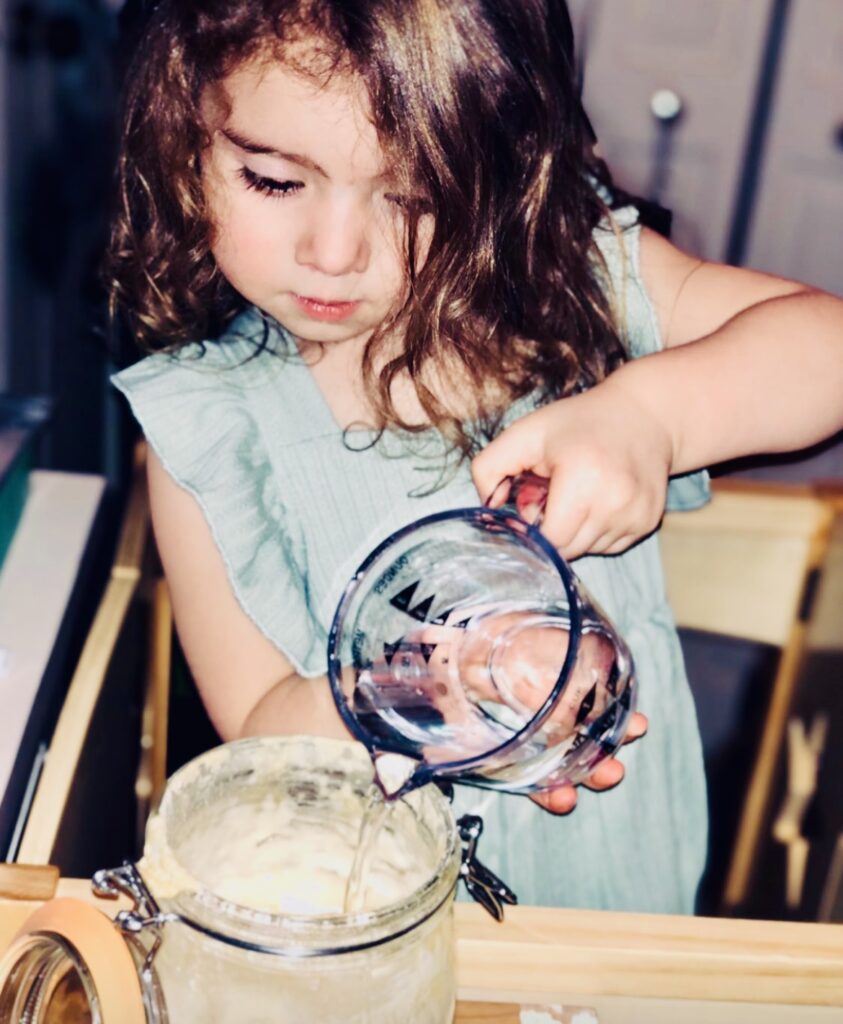
Fantastic Sourdough
Simple Ingredients
Flour and water
This versatile/reliable ingredient can be used to make tasty treats like bread, cookies, cakes and immeasurably more delicious homemade recipes.
The Hype of Sourdough
By now I’m sure you have heard of this traditional food that is incredibly SIMPLE! The health benefits make eating sourdough a daily snack for our family. Check out an earlier post on The Rise of Sourdough.
I have made several starters over the past handful of years, that I have completely overthought!
Thanks to Lisa over at The Farmhouse on Boone she gave me the confidence to try again, and I’m so glad I did, and had Sofie’s little hands helping the entire way. I can tell you this little lady was so proud to be helping Mama!
We use it all the time!

What is it?
So, what is Sourdough Starter?
Put very simply, it is a LIVE active culture of flour and water that has fermented and is full of beneficial bacteria and yeasts.
Typically used to naturally rise bread as well to ferment recipes!
We Love Our Sourdough
Why we love Sourdough and I why I think you will too–There are so many reasons why I have jumped in headfirst to making this for my family and incorporating it however I can!
Traditionally this homemade starter is a colony of beneficial yeast & Bacteria, has been made in kitchens for generations, passed down to be shared with great reverence while being highly valued long before yeast was able to be packaged! My goal is to have the starter I started with Sofie to pass on to all my kiddos!

Who Doesn’t Want to Be Healthy?
There are incredible health benefits:
- Easy to digest
- Lower glycemic index
- Better for gluten- sensitivity
- More “goud-acid”
- Higher levels of lactic acid which leads to more minerals being accessible. Less phytic acid (more on that later)
- Healthy bacteria
- Less yeast
- Natural origins
- Few preservatives
- Good fuel
- Fuels production of good bacteria in your gut
- Nutritious
- Moderate amounts of iron, manganese, calcium, B1-B6, B12, Folate, Zinc, Potassium, Thiamin, Niacin, Riboflavin, Selenium, Magnesium, Phosphorus, and Vitamin E
- **Sourdough maintains many original nutrients that are typically processed out of other kinds of bread**
- The Taste- Not really a health benefit but tastes great as a healthier option!
Phytic acid:
- Basically this is an anti-nutrient found in grains, beans, and nuts(keep them from spoiling) that hinder the absorption of nutrients.
- Phytic Acid is there for a reason, however there is overwhelming evidence that are bodies are meant to handle them! Which is why proper preparation of grains eliminates most if not all phytic acid.
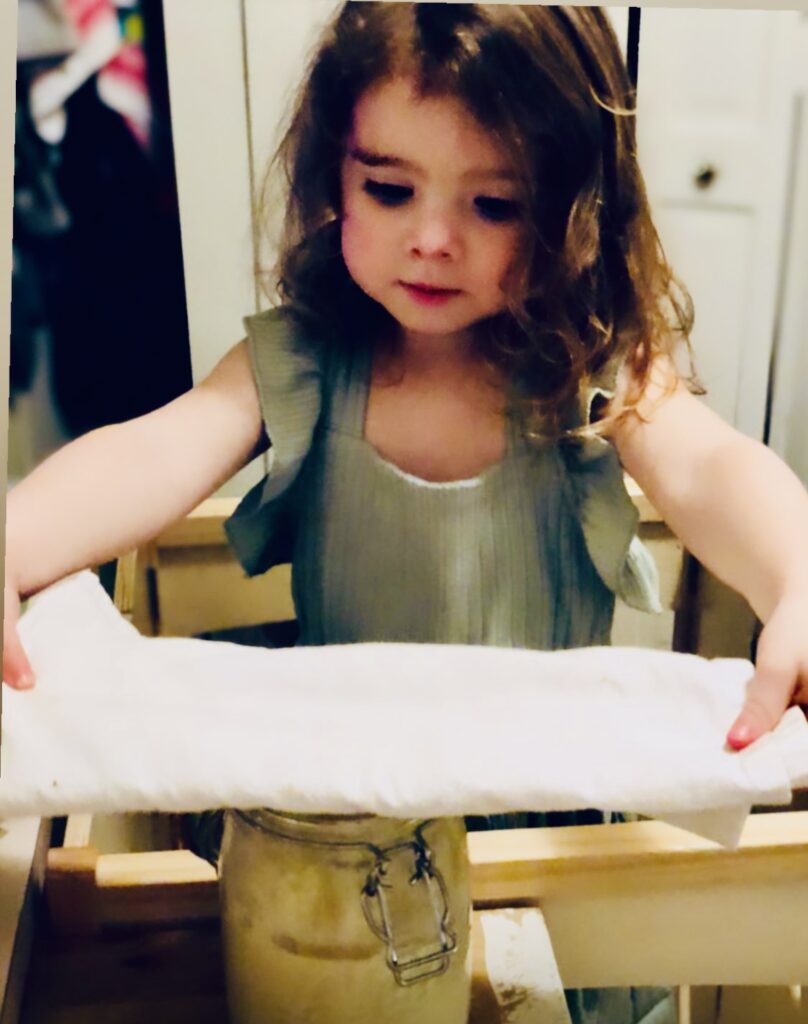
What is the proper preparation?
Traditional cultures typically soaked and fermented grains, seeds, and beans! Which allowed for more ability to tolerate grains (praying we can re-ignite this lost art of traditional homemade lifestyle!)
keep reading- how do we make this?
In hopes of providing a Simple Homemade Lifestyle to teach my girls and provide for my family, making this starter and seeing it growing into an active live starter often overflowing with bubbles, is extremely heartwarming and exciting!
And once you have had the opportunity to taste delectable Sourdough baked treats, you will never go back! The flavor is incomparable and not something you can package!
FAQ’s:
1: How long to make starter?
A: About a week to create an active sourdough starter but can take up to two weeks for start to be ready for a loaf of bread.
2: Do you have to discard every time you feed?
A: When first starting, YES! If you don’t discard you will have so much start it will be hard to keep healthy. (The more start you have the more flour & water you will need to add to feed the yeast and bacteria). ** After you have the started well started you can save the discard and make discard recipes (very useful, healthy, and less wasteful!
3: How do you know when starter is ready?
A: When you feed and 4-12HRS later is has doubled in size and is insanely bubbly (good way to determine, make a mark on the glass jar you are using i.e. rubber band where the top of the start was after feeding, check after a few HRS and see how much it has grown)
- Can also do a float test:
- Room temp water in a glass or bowl
- Add a dollup of active starter
- If it floats you are ready to bake!

Now You Know Why You Need to Have a Starter in Your Kitchen
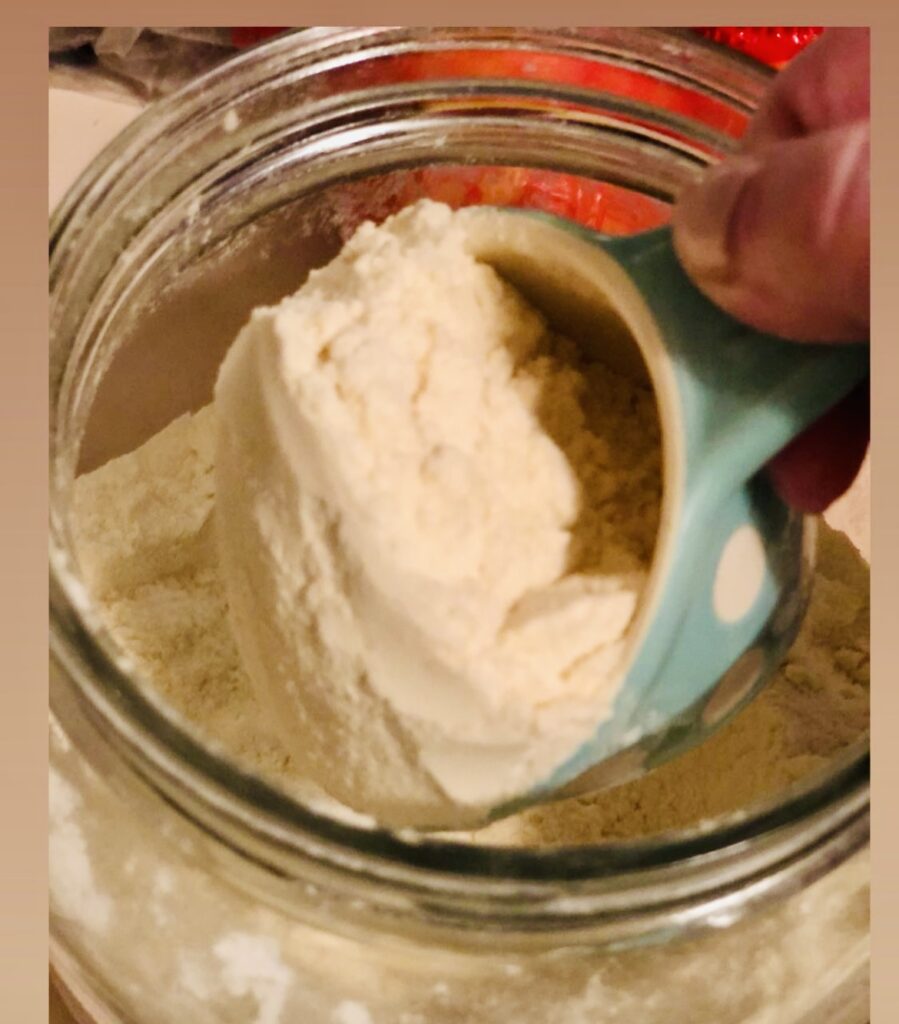
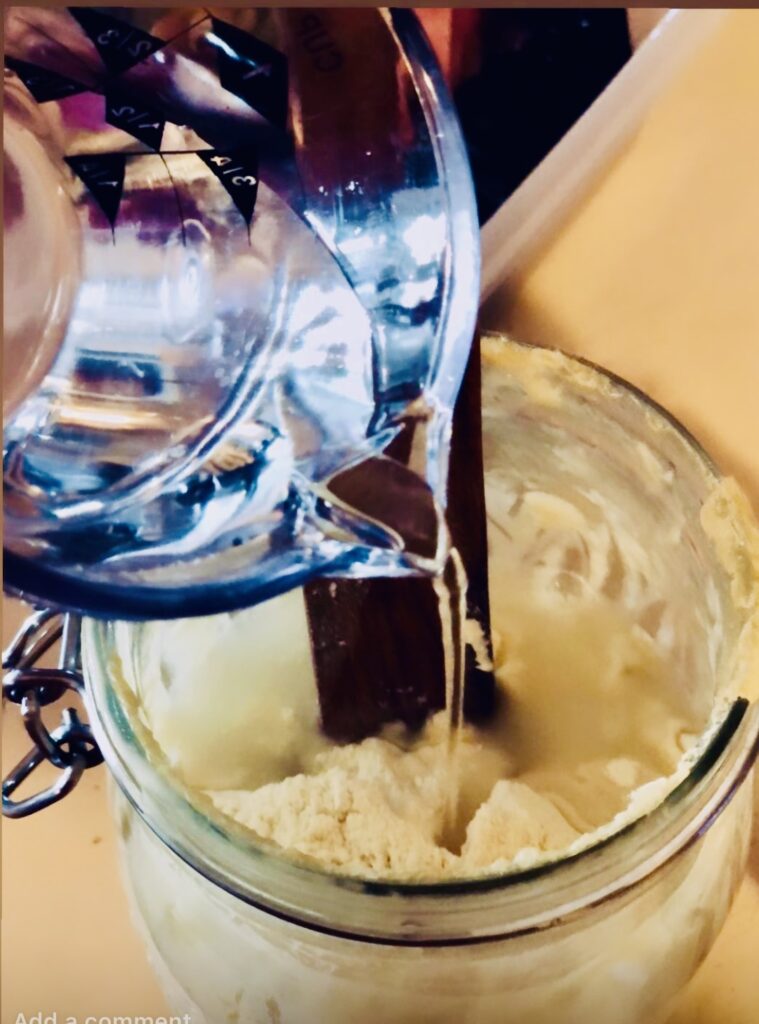
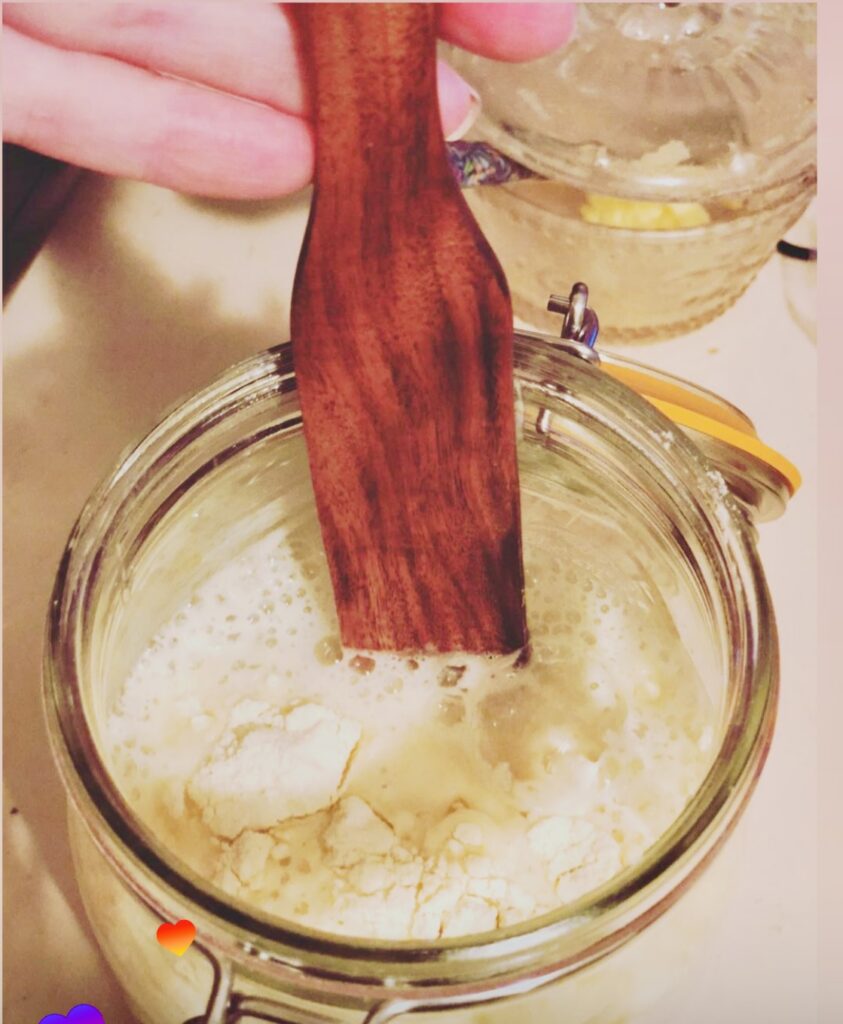
Sourdough Starter Recipe
Ingredients:
- Flour (Kamut, Einkorn (my 2 favorites)), but any whole-grain wheat, unbleached all purpose will work well too!
- Filtered water ( I use a Berkey water filter)
tools:
- Glass bowl/ jar (metal can react with beneficial yeast & bacteria)
- Wooden spoon
- Tea towel
Day 1:
- Mix 1 cup flour, 1 cup filtered water, stir vigorously, making sure to scrape down the sides, and make sure everything is incorporated well.
- Cover with a clean tea towel and set aside to sit for 24HRS
Day 2:
- Discard half the mixture, and then repeat the process!
- 1 cup flour, 1 cup filtered water (stir vigorously, cover, and set aside)
Day 3-5:
- Repeat day 2 instructions for days 3,4,and 5!
Day 6-7:
- On days 6 and 7, do the same but feed every 12HRS instead of every 24HRS
** By day 7 there should be enough beneficial bacteria and yeast present to bake sourdough bread and other fermented baked treats like scones, muffins, pancakes, English muffins, and so many more!
** You’ll know its working if it bubbles and doubles in size!
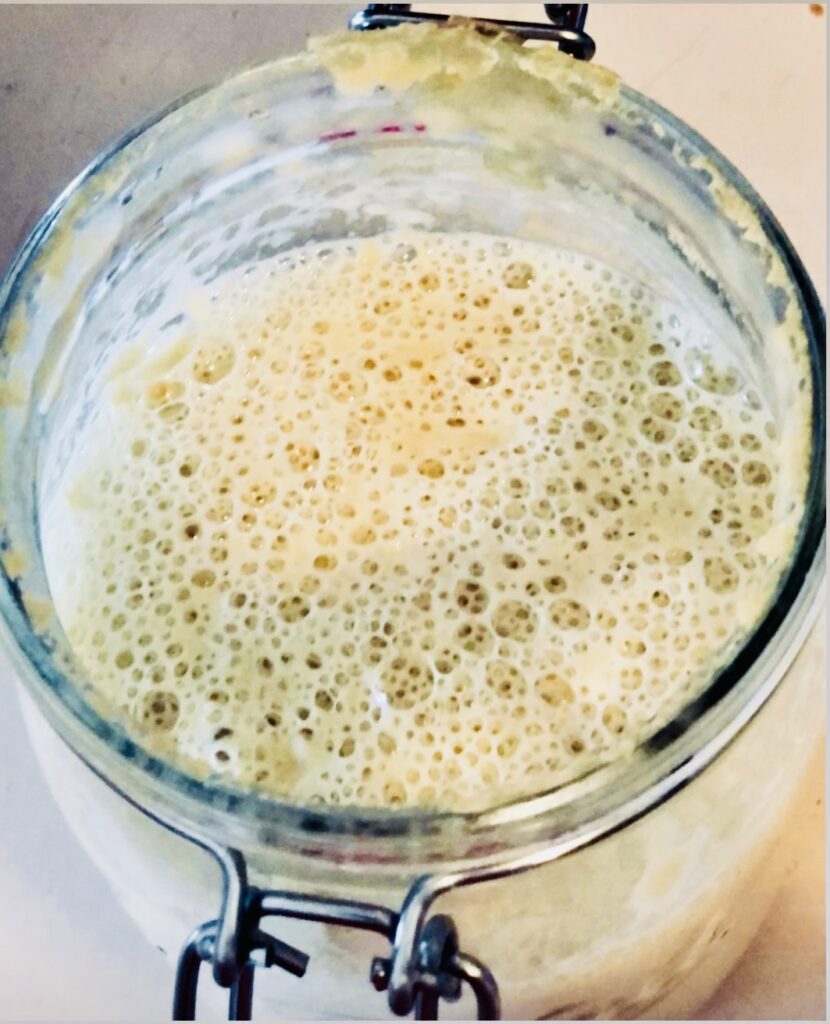
Continue to feed on the counter every 24HRS and Discard.
Maintenance:
- There is some maintenance to keep alive for years and years!
- Place in the fridge for occasional use—slows down fermentation process, so feeding once per week or every other week is good! (I have gone a month at a time… and then feed again to bring it back to life—it does take some time to bring back!)
- Additionally if I plan to make something I pull my starter out of the fridge the morning before and feed—by the next morning it should be good to go (if it has had a recent feed prior)
- Always save some starter to put back in the fridge (I recommend keeping in the fridge between uses!)
** Or you can keep on the counter & Feed Daily
**This post may contain affiliate links, which means I make a small commission at no extra cost to you**
Shop this post
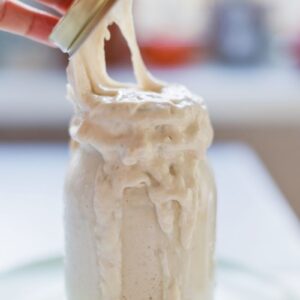
Sourdough Starter
Equipment
- Glass Jar
- Wooden Spoon
- Tea Towel
Ingredients
- 1 cup Kamut Flour Kamut and Einkorn are my favorites but could use any whole grain unbleached flour you prefer
- 1 cup Filtered Water
Instructions
- Day 1:Mix 1 cup flour, 1 cup filtered water, stir vigorously, making sure to scrape down the sides, and make sure everything is incorporated well. Cover with a clean tea towel and set aside to sit for 24HRS
- Day 2:Discard half the mixture, and then repeat the process! 1 cup flour, 1 cup filtered water (stir vigorously, cover, and set aside)
- Day 3-5:Repeat day 2 instructions for days 3,4,and 5!
- Day 6-7:On days 6 and 7, do the same but feed every 12HRS instead of every 24HRS